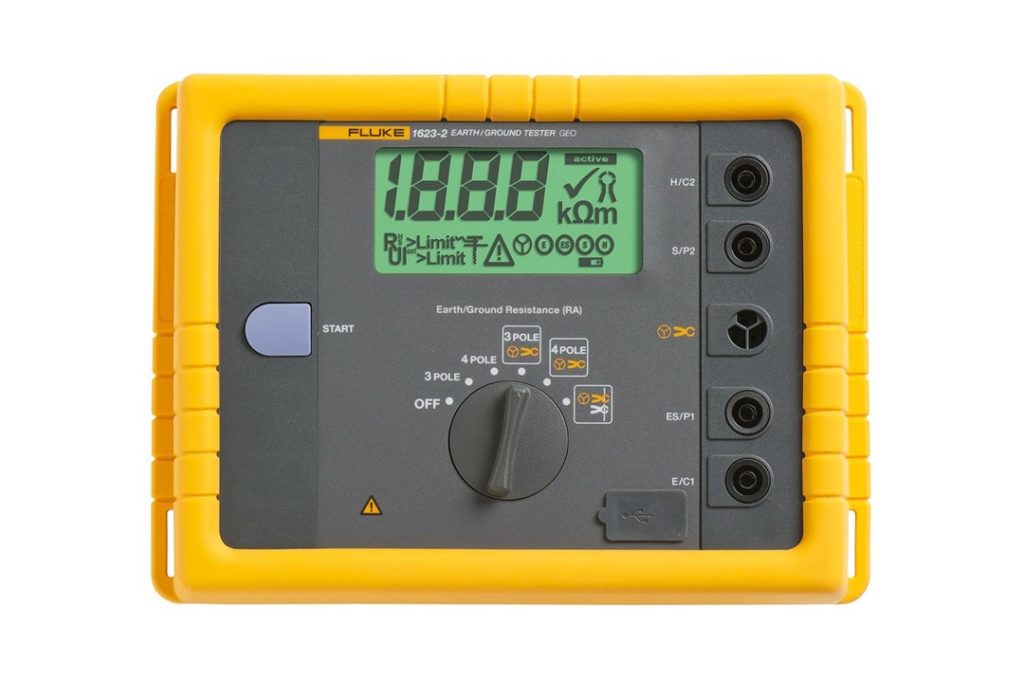Fluke’s Earth Ground Resistance Meter
Earth and ground resistance testers are critical electrical tools for ensuring that appliances and equipment have enough grounding resistance. Ground and earth meters are critical for establishing a safe path to earth in the event of a utility overvoltage or a lightning strike. Ground resistance varies from regular resistors by having the following specific characteristics:
Polarizing action
Since the earth functions like an electrolyte, it has polarizing action, which means that a DC current generates electromotive force in the opposite direction, making accurate measurement impossible. As a result, ground resistance is typically measured using a square or sine wave with frequencies ranging from several dozens of hertz to 1 kHz.
Special measurement setup
Ground resistance refers to the resistance between a grounding electrode and the earth. It is impossible to measure without first placing the electrode on the ground. Because earth has a low resistivity, a voltage drop occurs near the electrode where the current for the measurement flows. As a result, to precisely measure the resistance value of each grounding electrode (the E electrode, S [P] electrode, and H [C] electrode), you must go roughly 10 m away.
Existence of disturbances
Ground resistance measurements are influenced by factors such as ground potential and the impact of supplemental grounding electrodes. The ground potential created by leakage current from devices connected to the grounding electrode is superimposed on the signal detected by the ground resistance tester, altering the observed values. Furthermore, if the auxiliary grounding electrodes have a large ground resistance, the measuring current decreases, making them more susceptible to noise effects such as ground potential.

Fluke 1632-2 GEO Earth Ground Tester
Fluke 1623-2 is a high-precision earth ground tester with built-in memory, four alternative testing methodologies, and a number of other important features. This tester can perform 3 and 4 pole fall of potential, earth resistance loop, 4 pole soil resistivity, selective earth ground, and stakeless earth ground tests. All of the information from each test can be stored immediately on the tester’s memory before being sent to a PC via USB connection.
The 1632-2, like other Fluke products, is durable, dependable, and accurate. Its IP56 rating allows it to be used outside, and its compact, user-friendly design makes it ideal for mobile use.
Key Features:
- IP56 rated for outdoor use.
- 4-pole Soil Resistivity testing.
- USB data storage and transfer.
- 3- and 4-pole Fall of Potential, earth resistance loop testing.
- Selective earth ground rod testing using 1 clamp.
- Stakeless earth ground rod testing using 2 clamps.
- Professional carrying case.
The Fluke 1623-2 earth ground testers can measure earth ground loop resistance with simple clamps. This test method involves placing two clamps around the earth ground rod and connecting each to the tester. There are no earth stakes used at all. The first clamp induces a known, fixed voltage, while the second clamp measures the current. The tester then automatically calculates the resistance of the earth ground rod.
Stakeless testing eliminates the need to detach the earth ground rod, preserving the bonded earth ground system during testing. Gone are the days of spending time setting and connecting stakes for each earth ground rod on your system, which is a significant time saver. You can also conduct earth-ground tests in unexpected locations, such as inside buildings, electricity pylons, or anywhere there is no access to soil.
Fluke’s electrical earth ground testers have been designed to cover the complete range of ground testing procedures, from the most basic to the most complicated. Our testers have been developed to be precise, safe, and simple to use. We offer quick and precise resistance tests using a variety of test methods, including three- and four-pole fall-of-potential testing, selected measurement testing, stakeless testing, and two-pole testing.
